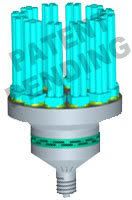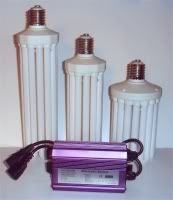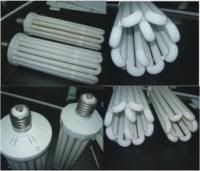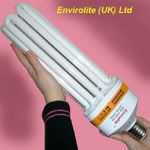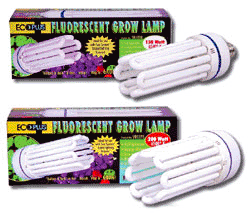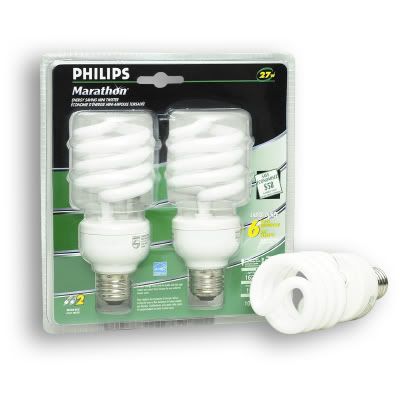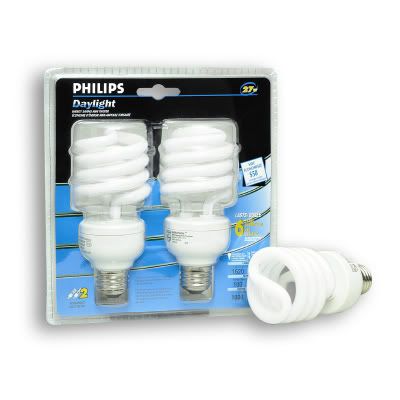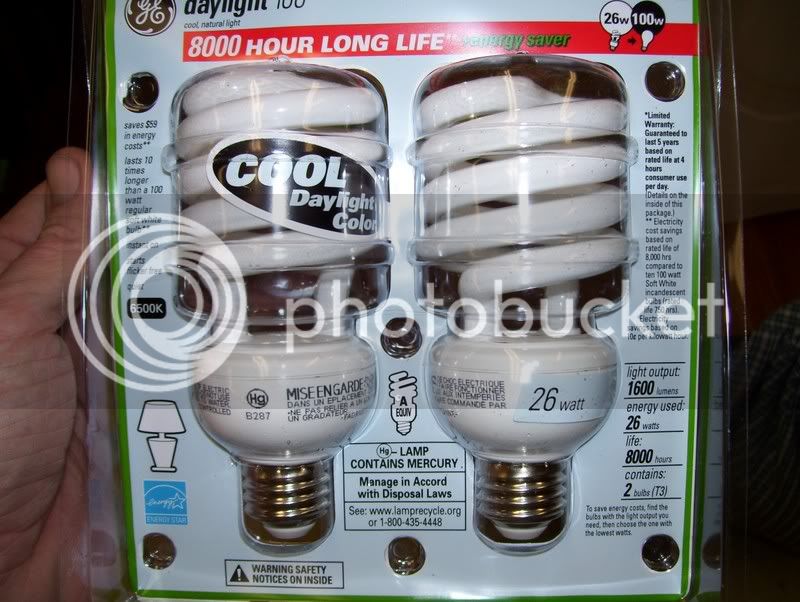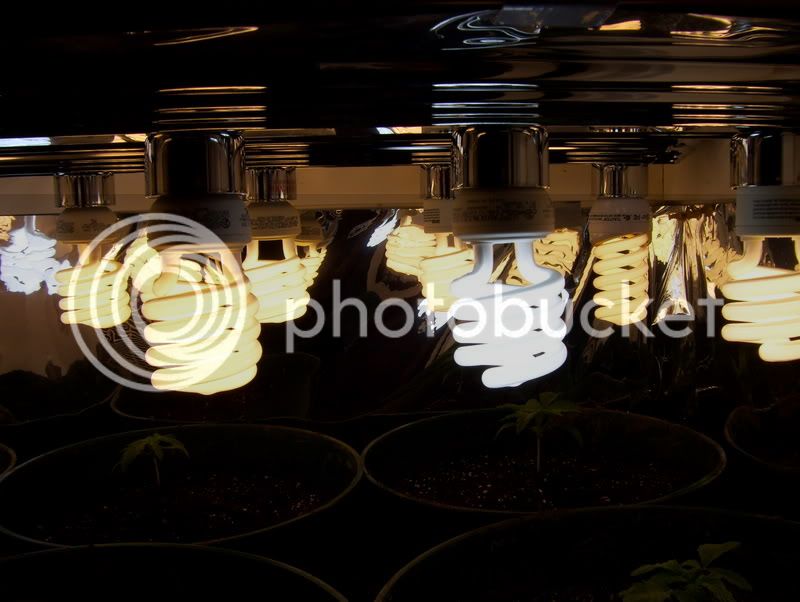cyberquest
Junior GreenThumb
- Joined
- Dec 22, 2006
- Messages
- 770
- Reaction score
- 82
ok so your new here and you seen everyone using CFL (compact flourescent) lighting and you have tons of questions. should i get bright white, cool white, warm white? fear not my freind cause i am going to cover with you a few of the basics of CFL lighting. 
first lets talk about their wattage, most CFL are energy savers, this is a added bonus. a 26 watt CFL is compairable to a regular 100w incandecent bulb, puts out the same amount of light , it just uses lower wattage. common sense tells us that the higher the wattage the more light it puts out, so yes you want to find the highest rated light you can.
second each bulb also has a lumens rating, this is a measurement of percieved value that our eyes see, the higher the lumens, the more light it produces. when you choose your bulbs make sure you find the one with the highest lumens output, this should be listed on the package.
third we have color temperature spectrum, better translated as Kelins, each bulb has a kelvin color rating as well, and this will be one of the most important parts of choosing your bulb! plants need light in the lower temperature scale to simulate the summer months for veg, and they need a higher temp spectrum of light for flowering. some packages are marked with the color spectrum as well, some are not, you might have to get on the bulbs web site to find out more info. if it is marked on the package it will be rated like this: 2700k ( the k stands for kelvins) 3000k, 4000k, 5000k, and so on and so forth.
Just as humans need a balanced diet, plants need balanced, full-spectrum light for good health and optimum growth. The quality of light is as important as quantity. Plants are sensitive to a similar portion of the spectrum as is the human eye. This portion of the light spectrum is referred to as photosynthetically active radiation or PAR, namely about 400 to 700 nanometers in wavelength. Nevertheless, plant response within this region is very different from that of humans.
The human eye has a peak sensitivity in the yellow-green region, around 550 nanometers. This is the "optic yellow" color used for highly visible signs and objects. Plants, on the other hand, respond more effectively to red light and to blue light, the peak being in the red region at around 630 nanometers. The graphs below show the human eye response curve and the plant response curve. Note the vast difference in the contours.
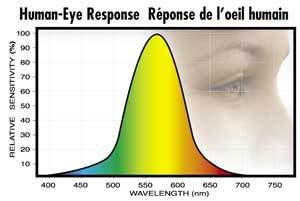
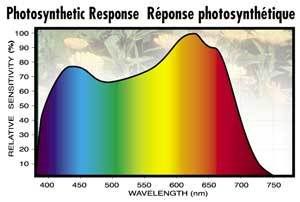
so seeing the above charts tell us that a bulb that is best rated for our eye, isnt even close to what is going to get the best response from the plant. so we need to keep this in mind when buying ANY bulb not just CFL lights. you can see the plants peak sensitivity is at 425nm and 625nm, so if you research your light to fall into these peak spectrums of light your going to get bigger yeilds from your plants. our eyes are peak sensativity is at around 575nm so a bulb that is used to give us peak lighting isnt what is best for out plants.
ok your still with me, but maybe your a tad confused with all the technical mumbo jumbo. lets give you another scale to maybe help understand a little easier.

here you can see the K relation on the NW scale, notice the curve of each color temperature spectrum and how much different they are.
the bottom K numbers are scales to represent colors of light that we see (K).
9300K = sunlight rated bulbs
6500K = bright white
5000K = soft white
3200K = warm white
you can see on the scale above each lights color temp spectrum in relation to the NM color spectrum that plants see. plants peak sensitivity to light is 425nw for vegatative growth, so which bulb above would be best for our plants? if you answered 6500K get up go to the kitchen and get yourself a cookie cause you did good so this tells us that a 6500k bulb would be best suited for us to use to grow seedlings in their veg stage.
so this tells us that a 6500k bulb would be best suited for us to use to grow seedlings in their veg stage.
REMEMBER this about the K scale, this is a scale set and used by the light industry to give ratings to bulbs based on what is best suited to our eyes!
this above scale isnt a good scale to choose our flower bulb with cause its a rough scale of the basic standards set by the light industry.
so how do i choose my flowering CFL bulb, well best i can say is with research, here is a example of a bulbs output as provided by its manufacturer.
here is a graph on a Sylvania 30w CFL, 1700 lumens, rated at 3000K
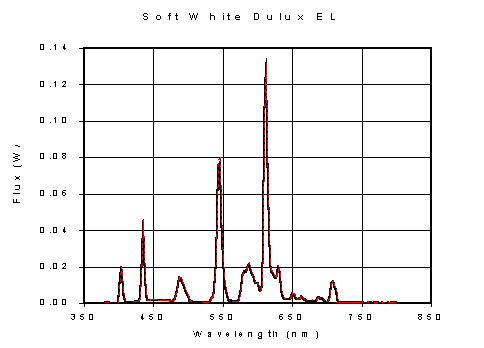
bulb specs: 1700 lumens 3000k
you can see that the bulbs peak output is right around 625nm, and where is our plants PEAK sensitivity for flower at? same as this bulbs peak output, so this bulb would be great if you are going to flower with a CFL bulb.
ok so you now have a basic understanding of what CFL bulb you are looking for, but i will tell you know that finding a 6500k CFL is gonna take some searching, WHY? because our eyes are more sensitive to the 575nm range, which is in the warm white bulb range, so 90% of CFL bulbs are going to be in this range because it will APPEAR brighter to our eyes. but at the end of this topic i will give you a link to some SUPER awsome CFL bulbs so dont worry, i got you covered
now we need to talk about something else, LIGHT INTENSITY. this too is very important for growing plants! Light intensity diminishes the further it has to travel. This is the same for HID, CFL or your normal household lamp. If you hold a light meter up close to any lamp and then slowly lower the meter, even a few inches, you will see the light measurement reduces dramatically.
so what does this tell us? the farther the bulb is away from the plant, the less intense the light is to the plant. light intensity reduces by half for every foot it is away from the plants. So if your bulbs are a foot above your plants much of the light is wasted or lost. not to fear though because a CFL produces much less heat then a HID bulb (MH & HPS) so you want the bulb as close as possible to the plant without burning it so that you arent loosing the intensity of the light.
that being said i want to talk about HID lights for a second. The problem with HID lamps is they are so hot you cannot place them close to your plants. a 400w HPS bulb is recommend to be at least 22 inches above the plant, and remember what you just read about light intensity at a foot away, so at 22 inches your almost two feet away from the plant much of the light, and your money, is wasted. there are special cooling hoods avalible for HID bulbs that help keep them cool, and if your using a HID lamp you need one so you dont loose the intensity of your light.
In the past fluorescent lamps were always known to have excellent 'daylight' colour output but not the same photon power as HID / HPS lamps. The spectrum from fluorescents was ideal for propagation/seedlings but not for real time growing, because they were small watt versions and did not have the lumen / photon output. (i.e. an average household fluorescent tube is only about 35 watts. Nice spectrum but low light output! )
The development of high-output compact fluorescent means you can now get the correct colour spectrum, always associated with fluorescents, but with much higher light output. This means that CFL's are now capable of much, much higher lumen output with all the benefits of the ideal, spectrum output.
Photon strength is still not as strong as HID Lamps (although with our new reflectors we are getting there) but because these new lamps generate much less heat they can be placed just inches of the leaves, and this is a very, very important factor when using grow lamps so that you dont loose your light intesity.
first lets talk about their wattage, most CFL are energy savers, this is a added bonus. a 26 watt CFL is compairable to a regular 100w incandecent bulb, puts out the same amount of light , it just uses lower wattage. common sense tells us that the higher the wattage the more light it puts out, so yes you want to find the highest rated light you can.
second each bulb also has a lumens rating, this is a measurement of percieved value that our eyes see, the higher the lumens, the more light it produces. when you choose your bulbs make sure you find the one with the highest lumens output, this should be listed on the package.
third we have color temperature spectrum, better translated as Kelins, each bulb has a kelvin color rating as well, and this will be one of the most important parts of choosing your bulb! plants need light in the lower temperature scale to simulate the summer months for veg, and they need a higher temp spectrum of light for flowering. some packages are marked with the color spectrum as well, some are not, you might have to get on the bulbs web site to find out more info. if it is marked on the package it will be rated like this: 2700k ( the k stands for kelvins) 3000k, 4000k, 5000k, and so on and so forth.
Just as humans need a balanced diet, plants need balanced, full-spectrum light for good health and optimum growth. The quality of light is as important as quantity. Plants are sensitive to a similar portion of the spectrum as is the human eye. This portion of the light spectrum is referred to as photosynthetically active radiation or PAR, namely about 400 to 700 nanometers in wavelength. Nevertheless, plant response within this region is very different from that of humans.
The human eye has a peak sensitivity in the yellow-green region, around 550 nanometers. This is the "optic yellow" color used for highly visible signs and objects. Plants, on the other hand, respond more effectively to red light and to blue light, the peak being in the red region at around 630 nanometers. The graphs below show the human eye response curve and the plant response curve. Note the vast difference in the contours.


so seeing the above charts tell us that a bulb that is best rated for our eye, isnt even close to what is going to get the best response from the plant. so we need to keep this in mind when buying ANY bulb not just CFL lights. you can see the plants peak sensitivity is at 425nm and 625nm, so if you research your light to fall into these peak spectrums of light your going to get bigger yeilds from your plants. our eyes are peak sensativity is at around 575nm so a bulb that is used to give us peak lighting isnt what is best for out plants.
ok your still with me, but maybe your a tad confused with all the technical mumbo jumbo. lets give you another scale to maybe help understand a little easier.

here you can see the K relation on the NW scale, notice the curve of each color temperature spectrum and how much different they are.
the bottom K numbers are scales to represent colors of light that we see (K).
9300K = sunlight rated bulbs
6500K = bright white
5000K = soft white
3200K = warm white
you can see on the scale above each lights color temp spectrum in relation to the NM color spectrum that plants see. plants peak sensitivity to light is 425nw for vegatative growth, so which bulb above would be best for our plants? if you answered 6500K get up go to the kitchen and get yourself a cookie cause you did good
REMEMBER this about the K scale, this is a scale set and used by the light industry to give ratings to bulbs based on what is best suited to our eyes!
this above scale isnt a good scale to choose our flower bulb with cause its a rough scale of the basic standards set by the light industry.
so how do i choose my flowering CFL bulb, well best i can say is with research, here is a example of a bulbs output as provided by its manufacturer.
here is a graph on a Sylvania 30w CFL, 1700 lumens, rated at 3000K

bulb specs: 1700 lumens 3000k
you can see that the bulbs peak output is right around 625nm, and where is our plants PEAK sensitivity for flower at? same as this bulbs peak output, so this bulb would be great if you are going to flower with a CFL bulb.
ok so you now have a basic understanding of what CFL bulb you are looking for, but i will tell you know that finding a 6500k CFL is gonna take some searching, WHY? because our eyes are more sensitive to the 575nm range, which is in the warm white bulb range, so 90% of CFL bulbs are going to be in this range because it will APPEAR brighter to our eyes. but at the end of this topic i will give you a link to some SUPER awsome CFL bulbs so dont worry, i got you covered
now we need to talk about something else, LIGHT INTENSITY. this too is very important for growing plants! Light intensity diminishes the further it has to travel. This is the same for HID, CFL or your normal household lamp. If you hold a light meter up close to any lamp and then slowly lower the meter, even a few inches, you will see the light measurement reduces dramatically.
so what does this tell us? the farther the bulb is away from the plant, the less intense the light is to the plant. light intensity reduces by half for every foot it is away from the plants. So if your bulbs are a foot above your plants much of the light is wasted or lost. not to fear though because a CFL produces much less heat then a HID bulb (MH & HPS) so you want the bulb as close as possible to the plant without burning it so that you arent loosing the intensity of the light.
that being said i want to talk about HID lights for a second. The problem with HID lamps is they are so hot you cannot place them close to your plants. a 400w HPS bulb is recommend to be at least 22 inches above the plant, and remember what you just read about light intensity at a foot away, so at 22 inches your almost two feet away from the plant much of the light, and your money, is wasted. there are special cooling hoods avalible for HID bulbs that help keep them cool, and if your using a HID lamp you need one so you dont loose the intensity of your light.
In the past fluorescent lamps were always known to have excellent 'daylight' colour output but not the same photon power as HID / HPS lamps. The spectrum from fluorescents was ideal for propagation/seedlings but not for real time growing, because they were small watt versions and did not have the lumen / photon output. (i.e. an average household fluorescent tube is only about 35 watts. Nice spectrum but low light output! )
The development of high-output compact fluorescent means you can now get the correct colour spectrum, always associated with fluorescents, but with much higher light output. This means that CFL's are now capable of much, much higher lumen output with all the benefits of the ideal, spectrum output.
Photon strength is still not as strong as HID Lamps (although with our new reflectors we are getting there) but because these new lamps generate much less heat they can be placed just inches of the leaves, and this is a very, very important factor when using grow lamps so that you dont loose your light intesity.



